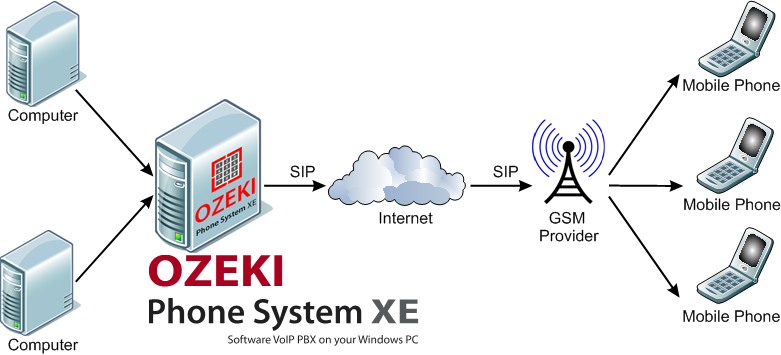VoIP vs. GSM
In this page you can get informed about VoIP and GSM protocols and their relations in advanced, modern communication systems. If you are interested in having a phoning system that is to communicate with anyone who has a phoning device - without taking into consideration WHAT kind of device your partner has - then this article is the perfect help for you.
VoIP (Voice over Internet Protocol) is the protocol that makes all types of multimedia data transferable through the Internet. Every time when a text, audio or video call or conference is made via the Internet, the data is transferred according to the rules of VoIP protocol.
GSM (Global System for Mobile Communications) is responsible for the phone calls and SMS, MMS sending via the mobile service providers' networks.

VoIP and GSM
When a user initiates a VoIP call from a computer or another proper device, it goes through the Internet and arrives to another VoIP computer or device. The same happens when a mobile phone calls another mobile phone: the two devices communicate via the same gsm system.
But what happens if somebody wants to make a call from a computer to a mobile phone? In this case the two networks must be connected: the network connection can be done with the help of a server, also known as a PBX (Private Branch Exchange) and the proper gateways. In your Ozeki Phone System, you can find both the PBX and the VoIP GSM gateways that are needed.
Connection of the Networks
A server is the centre of the telecommunication systems: it controls the switching, the forwarding, the automatic answering etc. tasks, according to the configurations. The two main tasks of a server are the call management and the connection of different networks. The latter one is used for making multimedia calls from one network (e.g. from VoIP) to another one (e.g. to GSM).
A server can connect the different networks with the help of the gateways: these tools are physical elements of the system. There are gateways for every kind of network: GSM gateway, SMS gateway, GSM VoIP gateway, PRI (Primary Rate Interface) GSM gateway, etc. In order to have a full feature communication system, a server must be equipped with all the gateways that may become in use.
The Ozeki Server
If you want to have a full feature communication system to make every kind of calls and send all types of messages, you will need a server with all the gateways. With the Ozeki Phone System, you avoided the trouble of building up such a system and had one ready.
The Ozeki Phone System is designed to manage all your calls and messages and to forward them from one network to another one. While doing this, Ozeki Phone System ensures you about the high quality, maximum reliability and full accessibility.
NOTE. Please do not forget however that the calls and messages go through the Ozeki Phone System server, the networks that you use will not become free, so the users must pay the charges for using the networks (e.g. the call charges for the local calls or the price of the SMS).
To get to know more about Internet-based telecommunication, please read through our related pages:
